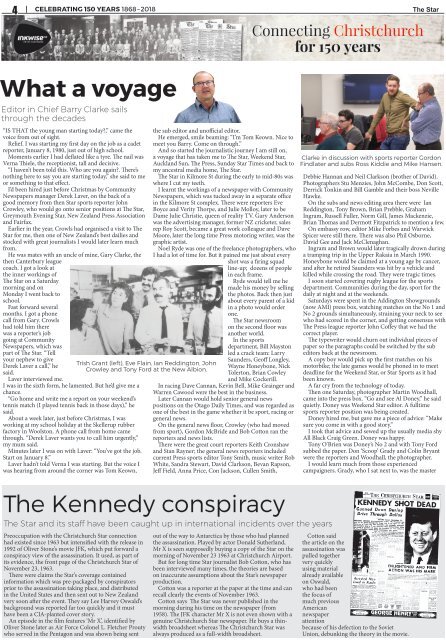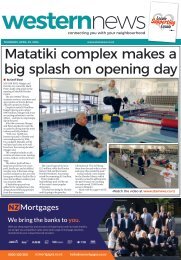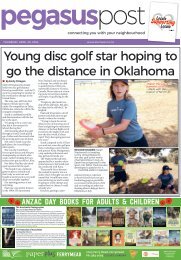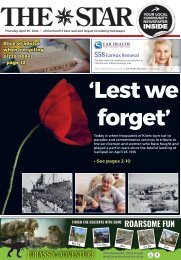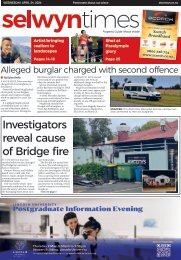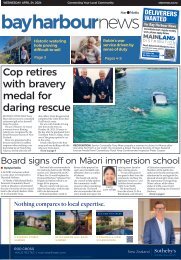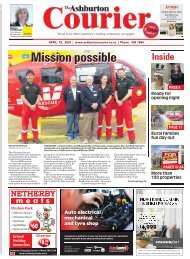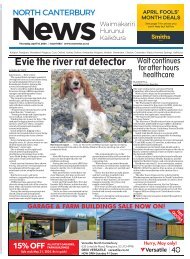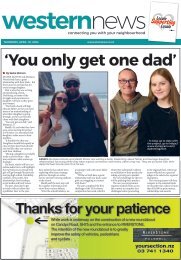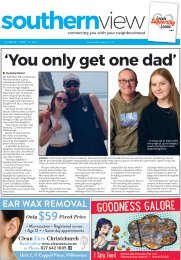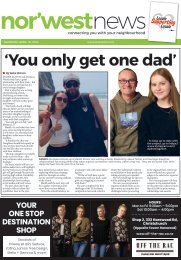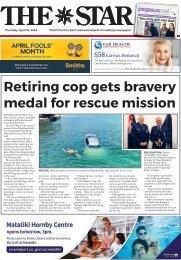The Star: July 05, 2018
You also want an ePaper? Increase the reach of your titles
YUMPU automatically turns print PDFs into web optimized ePapers that Google loves.
4<br />
CELEBRATING 150 YEARS 1868 – <strong>2018</strong><br />
Connecting Christchurch<br />
for 150 years<br />
<strong>The</strong> <strong>Star</strong><br />
What a voyage<br />
Editor in Chief Barry Clarke sails<br />
through the decades<br />
“IS THAT the young man starting today?,” came the<br />
voice from out of sight.<br />
Relief. I was starting my first day on the job as a cadet<br />
reporter, January 8, 1980, just out of high school.<br />
Moments earlier I had deflated like a tyre. <strong>The</strong> nail was<br />
Verna Thiele, the receptionist, tall and decisive.<br />
“I haven’t been told this. Who are you again?. <strong>The</strong>re’s<br />
nothing here to say you are starting today,” she said to me<br />
or something to that effect.<br />
I’d been hired just before Christmas by Community<br />
Newspapers manager Derek Laver, on the back of a<br />
good memory from then <strong>Star</strong> sports reporter John<br />
Crowley, who would go onto senior positions at <strong>The</strong> <strong>Star</strong>,<br />
Greymouth Evening <strong>Star</strong>, New Zealand Press Association<br />
and Fairfax.<br />
Earlier in the year, Crowls had organised a visit to <strong>The</strong><br />
<strong>Star</strong> for me, then one of New Zealand’s best dailies and<br />
stocked with great journalists I would later learn much<br />
from.<br />
He was mates with an uncle of mine, Gary Clarke, the<br />
then Canterbury league<br />
coach. I got a look at<br />
the inner workings of<br />
<strong>The</strong> <strong>Star</strong> on a Saturday<br />
morning and on<br />
Monday I went back to<br />
school.<br />
Fast forward several<br />
months. I got a phone<br />
call from Gary. Crowls<br />
had told him there<br />
was a reporter’s job<br />
going at Community<br />
Newspapers, which was<br />
part of <strong>The</strong> <strong>Star</strong>. “Tell<br />
your nephew to give<br />
Derek Laver a call,” he<br />
said.<br />
Laver interviewed me.<br />
I was in the sixth form, he lamented. But he’d give me a<br />
chance.<br />
“Go home and write me a report on your weekend’s<br />
tennis match (I played tennis back in those days),” he<br />
said.<br />
About a week later, just before Christmas, I was<br />
working at my school holiday at the Skellerup rubber<br />
factory in Woolston. A phone call from home came<br />
through. “Derek Laver wants you to call him urgently,”<br />
my mum said.<br />
Minutes later I was on with Laver: “You’ve got the job.<br />
<strong>Star</strong>t on January 8.”<br />
Laver hadn’t told Verna I was starting. But the voice I<br />
was hearing from around the corner was Tom Keown,<br />
Trish Grant (left), Eve Flain, Ian Reddington, John<br />
Crowley and Tony Ford at the New Albion.<br />
the sub editor and unofficial editor.<br />
He emerged, smile beaming: “I’m Tom Keown. Nice to<br />
meet you Barry. Come on through.”<br />
And so started the journalistic journey I am still on,<br />
a voyage that has taken me to <strong>The</strong> <strong>Star</strong>, Weekend <strong>Star</strong>,<br />
Auckland Sun, <strong>The</strong> Press, Sunday <strong>Star</strong> Times and back to<br />
my ancestral media home, <strong>The</strong> <strong>Star</strong>.<br />
<strong>The</strong> <strong>Star</strong> in Kilmore St during the early to mid-80s was<br />
where I cut my teeth.<br />
I learnt the workings of a newspaper with Community<br />
Newspapers, which was tucked away in a separate office<br />
in the Kilmore St complex. <strong>The</strong>re were reporters Eve<br />
Boyce and Verity Thorpe, and Julie Molloy, later to be<br />
Dame Julie Christie, queen of reality TV. Gary Anderson<br />
was the advertising manager, former NZ cricketer, sales<br />
rep Roy Scott, became a great work colleague and Dave<br />
Moore, later the long time Press motoring writer, was the<br />
graphic artist.<br />
Noel Ryde was one of the freelance photographers, who<br />
I had a lot of time for. But it pained me just about every<br />
shot was a firing squad<br />
line-up; dozens of people<br />
in each frame.<br />
Ryde would tell me he<br />
made his money by selling<br />
the photos. Back then just<br />
about every parent of a kid<br />
in a photo would order<br />
one.<br />
<strong>The</strong> <strong>Star</strong> newsroom<br />
on the second floor was<br />
another world.<br />
In the sports<br />
department, Bill Mayston<br />
led a crack team: Larry<br />
Saunders, Geoff Longley,<br />
Wayne Honeybone, Nick<br />
Tolerton, Brian Cowley<br />
and Mike Cockerill.<br />
In racing Dave Cannan, Kevin Bell, Mike Grainger and<br />
Warren Cawood were the best in the business.<br />
Later Cannan would hold senior general news<br />
positions on the Otago Daily Times, and was regarded as<br />
one of the best in the game whether it be sport, racing or<br />
general news.<br />
On the general news floor, Crowley (who had moved<br />
from sport), Gordon McBride and Bob Cotton ran the<br />
reporters and news lists.<br />
<strong>The</strong>re were the great court reporters Keith Cronshaw<br />
and Stan Rayner; the general news reporters included<br />
current Press sports editor Tony Smith, music writer Rob<br />
White, Sandra Stewart, David Clarkson, Bevan Rapson,<br />
Jeff Field, Anna Price, Con Jackson, Cullen Smith,<br />
Clarke in discussion with sports reporter Gordon<br />
Findlater and subs Ross Kiddie and Mike Hansen.<br />
Debbie Hannan and Neil Clarkson (brother of David).<br />
Photographers Stu Menzies, John McCombe, Don Scott,<br />
Derrick Tonkin and Bill Gamble and their boss Neville<br />
Hawke.<br />
On the subs and news editing area there were Ian<br />
Reddington, Tony Brown, Brian Prebble, Graham<br />
Ingram, Russell Fuller, Norm Gill, James Mackenzie,<br />
Brian Thomas and Dermott Fitzpatrick to mention a few.<br />
On embassy row, editor Mike Forbes and Warwick<br />
Spicer were still there. <strong>The</strong>re was also Phil Osborne,<br />
David Gee and Jack McClenaghan.<br />
Ingram and Brown would later tragically drown during<br />
a tramping trip in the Upper Rakaia in March 1990.<br />
Honeybone would be claimed at a young age by cancer,<br />
and after he retired Saunders was hit by a vehicle and<br />
killed while crossing the road. <strong>The</strong>y were tragic times.<br />
I soon started covering rugby league for the sports<br />
department. Communities during the day, sport for the<br />
daily at night and at the weekends.<br />
Saturdays were spent in the Addington Showgrounds<br />
(now AMI) press box, watching matches on the No 1 and<br />
No 2 grounds simultaneously, straining your neck to see<br />
who had scored in the corner, and getting consensus with<br />
<strong>The</strong> Press league reporter John Coffey that we had the<br />
correct player.<br />
<strong>The</strong> typewriter would churn out individual pieces of<br />
paper so the paragraphs could be switched by the sub<br />
editors back at the newsroom.<br />
A copy boy would pick up the first matches on his<br />
motorbike; the late games would be phoned in to meet<br />
deadline for the Weekend <strong>Star</strong>, or <strong>Star</strong> Sports as it had<br />
been known.<br />
A far cry from the technology of today.<br />
<strong>The</strong>n one Saturday, photographer Martin Woodhall,<br />
came into the press box. “Go and see Al Doney,” he said<br />
quietly. Doney was Weekend <strong>Star</strong> editor. A fulltime<br />
sports reporter position was being created.<br />
Doney hired me, but gave me a piece of advice: “Make<br />
sure you come in with a good story.”<br />
I took that advice and sewed up the usually media shy<br />
All Black Craig Green. Doney was happy.<br />
Tony O’Brien was Doney’s No 2 and with Tony Ford<br />
subbed the paper. Don ‘Scoop’ Grady and Colin Bryant<br />
were the reporters and Woodhall, the photographer.<br />
I would learn much from those experienced<br />
campaigners. Grady, who I sat next to, was the master<br />
<strong>The</strong> Kennedy conspiracy<br />
<strong>The</strong> <strong>Star</strong> and its staff have been caught up in international incidents over the years<br />
Preoccupation with the Christchurch <strong>Star</strong> connection<br />
had existed since 1963 but intensified with the release in<br />
1992 of Oliver Stone’s movie JFK, which put forward a<br />
conspiracy view of the assassination. It used, as part of<br />
its evidence, the front page of the Christchurch <strong>Star</strong> of<br />
November 23, 1963.<br />
<strong>The</strong>re were claims the <strong>Star</strong>’s coverage contained<br />
information which was pre-packaged by conspirators<br />
prior to the assassination taking place, and distributed<br />
in the United States and then sent out to New Zealand<br />
very soon after the event. <strong>The</strong>y say Lee Harvey Oswald’s<br />
background was reported far too quickly and it must<br />
have been a CIA-planted cover story.<br />
An episode in the film features ‘Mr X’, identified by<br />
Oliver Stone later as Air Force Colonel L. Fletcher Prouty<br />
who served in the Pentagon and was shown being sent<br />
out of the way to Antarctica by those who had planned<br />
the assassination. Played by actor Donald Sutherland,<br />
Mr X is seen supposedly buying a copy of the <strong>Star</strong> on the<br />
morning of November 23 1963 at Christchurch Airport.<br />
But for long time <strong>Star</strong> journalist Bob Cotton, who has<br />
been interviewed many times, the theories are based<br />
on inaccurate assumptions about the <strong>Star</strong>’s newspaper<br />
production.<br />
Cotton was a reporter at the paper at the time and can<br />
recall clearly the events of November 1963.<br />
Cotton says <strong>The</strong> <strong>Star</strong> was never published in the<br />
morning during his time on the newspaper (from<br />
1958). <strong>The</strong> JFK character Mr X is not even shown with a<br />
genuine Christchurch <strong>Star</strong> newspaper. He buys a thinwidth<br />
broadsheet whereas <strong>The</strong> Christchurch <strong>Star</strong> was<br />
always produced as a full-width broadsheet.<br />
Cotton said<br />
the article on the<br />
assassination was<br />
pulled together<br />
very quickly<br />
using material<br />
already available<br />
on Oswald,<br />
who had been<br />
the focus of<br />
much previous<br />
American<br />
newspaper<br />
attention<br />
85 YEARS<br />
GEORGE HENRY & CO.<br />
Mon to Fri 8am - 5.30pm, Sat 9am - 12.30pm • 47 Manchester Street, Christchurch. Phone: (03) 366 5186. Fax: (03) 366 2135. Freephone: 0800 33 10 33<br />
Email: sales@georgehenry.co.nz Website: www.georgehenry.co.nz<br />
because of his defection to the Soviet<br />
Union, debunking the theory in the movie.<br />
in<br />
TOOLS<br />
LTD<br />
85 YEARS<br />
in<br />
TOOLS<br />
323of030-08


